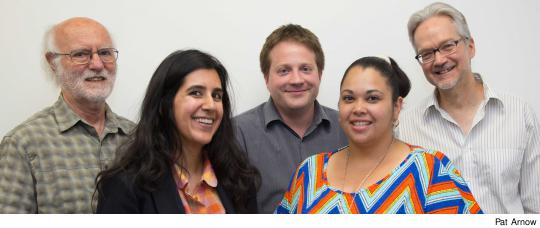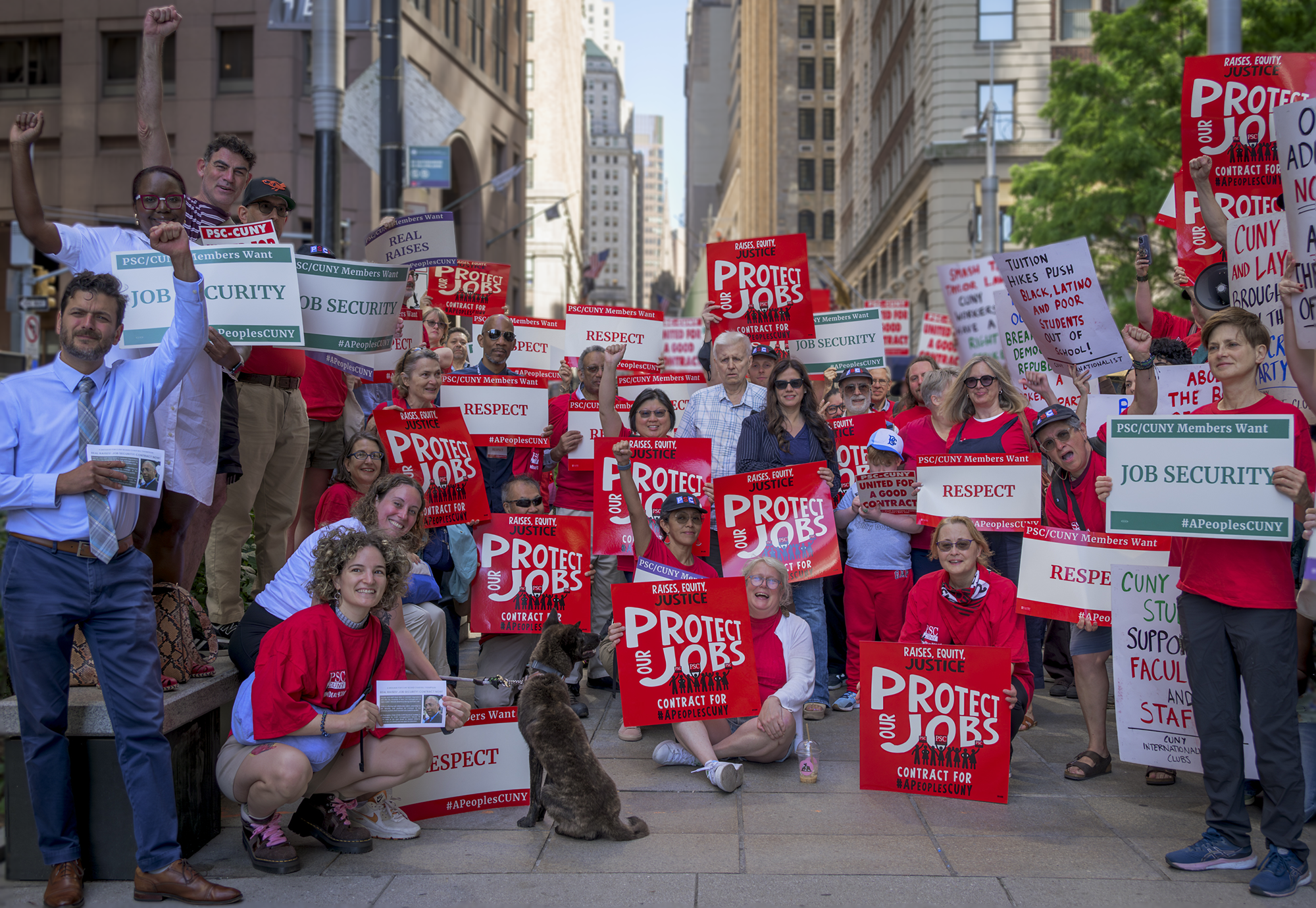Part of an occasional series on the departments and staff of the PSC. Previous articles on the Contract Enforcement Department and Membership Department have run in Clarion.
______________________________
The PSC reaches many audiences – its members, CUNY students, college and CUNY administrators, the public, the media, other unions, state and local officials. The union’s five-person communications department is charged with ensuring that each audience gets the information it needs.
 |
The union’s elected officers are the ultimate decision-makers in developing the PSC’s message and its communications strategy; those decisions set the direction for the communications department’s work. Communications staff approach their work as a collaborative team, working closely with the officers and each other on the wide range of projects for which they’re responsible.
Communications Coordinator Fran Clark is involved with more elements of the PSC’s communications efforts than anyone else in the department. He sums up his wide-ranging job succinctly: “It’s my job to figure out how to tell the story.”
At a practical level, that means outreach to reporters; writing the union’s email weekly newsletter, This Week in the PSC (sign up here), managing the PSC’s presence on Facebook (facebook.com/PSC.CUNY) and Twitter (@PSC_CUNY); sharing responsibility for the website; coordinating occasional ad buys in print, online and in radio and TV; and managing production of publicity materials for all the union’s events, from grassroots lobbying on the CUNY budget to Labor Goes to the Movies.
Clark, who holds a BA from SUNY Oneonta, calls himself a product of New York’s public higher education system. “I wouldn’t have been able to afford college otherwise,” he says, and that helped shaped his commitment to the issues PSC addresses. Before joining the PSC staff in 2011, Clark worked for 10 years at the NY Public Interest Research Group (NYPIRG) as its higher education program coordinator, lobbying, organizing students and building support for public higher education in New York State.
NYC Media
“I believe in the vision for public higher education that the union has,” says Clark. “I like that the PSC takes a lot of principled stances to advance that fight,” he says. “Helping to shape and deliver those messages is a challenge I enjoy.”
New York City is an intense and competitive media environment, but Clark has worked to expand the PSC’s presence over time. When CUNY announced its new chancellor, his work helped position the PSC to be prominently quoted as part of that story, with the union’s views cited in coverage by The New York Times, the Wall Street Journal, and online with the Chronicle of Higher Education’s blog of breaking news.
In today’s new media landscape, success can also come bottom-up – and while the union’s electronic media still has its broadest reach through the website and email newsletter, the PSC’s social media work has been paying off. For instance, social media photo shares helped make sure CUNY adjuncts became part of the focus of last December’s “New Day New York” march in support of NYC’s low-wage workers.
“We used photos of adjuncts teaching and collected personal stories to create a series of images promoting the rally,” says Clark. “These images also asserted very effectively that colleges and universities also exploit low-wage workers – it’s not just fast-food chains, car washes and Walmart.” These photo shares had greater reach, and more engagement, than any social media posts the PSC had done before, Clark says. They were a hit on Facebook and on the PSC Twitter feed, which is monitored and managed day-to-day by Moses Merisier, Assistant to the Associate Executive Director. Merisier began working to build the PSC’s Twitter following when the union expanded its social media bandwidth.
Visual Work
That campaign and other social media work are one area where Clark works closely with Amanda Magalhaes, the union’s Legislative/Communications Associate, who splits her time between the PSC’s communications department and its legislative work. Those two areas often overlap – for example, in producing the union’s annual “budget books” for grassroots lobbying on the State and City budgets. These booklets have to break down the sometimes arcane details of public budgeting in a way that’s clear, accessible, and show what’s at stake for CUNY. The timetable for those lobbying visits, which Magalhaes coordinates, and the timetable for producing the printed materials, led by Clark, have to closely coordinate.
Magalhaes has a bachelor’s degree in communications from St. John’s University, a master’s in Urban Affairs from CUNY’s Murphy Institute and a certificate in graphic design. “I do a lot of the visual work – scouting images, putting together graphics,” she explains. “I like the creative aspect.” Those skills are used in image-based emails and Facebook posts, but also in producing flyers, newsletters and other print materials. Magalhaes also manages the union’s digital photo archive.
“I didn’t come with a background in union work,” says Magalhaes, who first started working at the PSC as assistant to the union’s officers in 2002. But over time it’s become part of what makes her tick. “Labor history, labor issues, they resonate so much when you discuss them with colleagues,” she said – and that bigger-picture perspective helps inform the communications team in its day-to-day work.
Magalhaes, Clark and others contribute to the PSC’s website, but the web work is led by the union’s webmaster, Bill Friedheim, who has served in that changing role since 2000.
“It keeps me in the center of things at the PSC – the center of things not just at the office, but also what’s happening at the chapters,” says Friedheim. Before he retired from BMCC in 2006, Friedheim taught history there for four decades and served in several union leadership roles; he now chairs the Retirees Chapter.
It was “quite accidental” that he began to build websites, he says, a development rooted in his experience as a community college faculty member and a participant in the American Social History Project, based at the Grad Center. “Digital media was a real boon to teaching history, with primary sources, particularly at a community college that didn’t have a huge research library,” Friedheim says. “And discussion boards really enhanced student engagement.” He began by “experimenting a lot,” and soon he was building websites for his courses and leading teaching-in-tech workshops.
In 2000, Friedheim took on building and maintaining a website for the union. He did so, basically solo, for a decade. The site has changed dramatically since it began, and today Friedheim manages it as part of a committee, comprised of Clark, Magalhaes, PSC Associate Director Naomi Zauderer and Administrative Associate Patricia Young.
The team approach, Friedheim says, makes it much easier to keep the site up to date and think strategically about its direction. The integration of the website into the union’s communications work helps a lot, he says: “There’s an integrated strategy” for everything the department produces.
One of the most visited parts of the PSC’s website is the online edition of Clarion, the union’s newspaper. Both print and web editions are produced by Editor Peter Hogness and Associate Editor Shomial Ahmad, aided by Merisier in the online edition.
Since Hogness began as editor in 2001, Clarion has been consistently recognized by NYSUT, the AFT, and the International Labor Communications Association as one of the best local union newspapers in the United States and Canada. But when asked what stands out in his almost 14 years on the job, the first thing he mentions is developing Clarion’s letters column.
“When I became editor, Clarion hadn’t had a regular letters column, so it took a lot of tending. People didn’t have the expectation that you could write to Clarion and probably see your letter published.” Many PSC members may recall Hogness buttonholing them after a meeting to suggest that their comment from a half hour before might make a fine letter to the editor. “Over time, the letters column really took root,” he says. “It’s become the members’ soapbox, and readers often tell me it’s one of the first sections they turn to.”
Hogness’s own interest in politics began in high school, when he helped his mother organize support for the United Farm Workers grape and lettuce boycotts in the 1970s, and developed further while he was a student at Harvard studying the labor movement. He’s now been a labor activist for 35 years, and a journalist for 20.
After moving to New York in the 1980s, Hogness worked at the Amalgamated Clothing and Textile Workers Union and the US-Guatemala Labor Education Project. He first got into journalism as a freelancer, publishing in New York Newsday, the Village Voice, The New York Times, the Baltimore Sun and elsewhere. In the late 1990s he combined journalism and his labor interests working for a health-and-safety newsletter.
In producing Clarion, Hogness and Associate Editor Ahmad are joined by two long-serving freelancers, designer Margarita Aguilar (a former union activist at NYU) and copy editor Teri Duerr. “They’re both professionals who know, value and respect the work of the union. The fact that we’ve worked together for years, makes a big difference to the quality of the paper,” Hogness says.
Associate Editor Shomial Ahmad, the newest member of the PSC’s Communications Department, started work at the union last March. Like Hogness, she also moved to New York City after college and got hired as union staff. “I was politically active in college [at University of Texas-Austin] and New York felt like a good place to learn more about progressive politics,” she says. After working at the New Press for a year and a half as assistant to André Schiffrin, she took a job with the Taxi Workers Alliance in the aftermath of September 11th “to see how to make change happen.”
Individual Stories
It was exciting being part of a group that was inventing new forms of worker organizing, Ahmad says, and the group’s broad vision made it a good place to learn. But she found that the “straight-up political stuff” alone didn’t feed her creative side, a fact that led her to NYU’s journalism program. Ahmad freelanced for print publications in New York before landing a fellowship at National Public Radio in DC, then moved on to become a reporter for the NPR member stations in Atlanta and Houston. Ahmad’s sound production skills are on display in an audio slideshow on the PSC website about the September 29 contract demonstration.
“It’s lonely sometimes, working as a journalist, because you keep a distance from your sources,” Ahmad says. “But at a union publication, it’s different because part of the job is building unity and informing members, too. Digging deep into issues that affect the CUNY community means doing good journalism, and is part of supporting our members in their lives at work.”
A key part of reporting for Clarion, of course, is listening to PSC members – on the phone, online, and face to face. And that’s true across the board in the union’s communications work, where “figuring out how to tell the story” begins with the individual stories of members of the PSC. At the base of their work, department members say, is listening to PSC members, eliciting and amplifying their voices. That’s who the union’s communications work serves, and that’s whose experience it needs to reflect.

